STORY: Olin Students are First Undergraduates to Achieve Sustained Fire of Ion Thruster
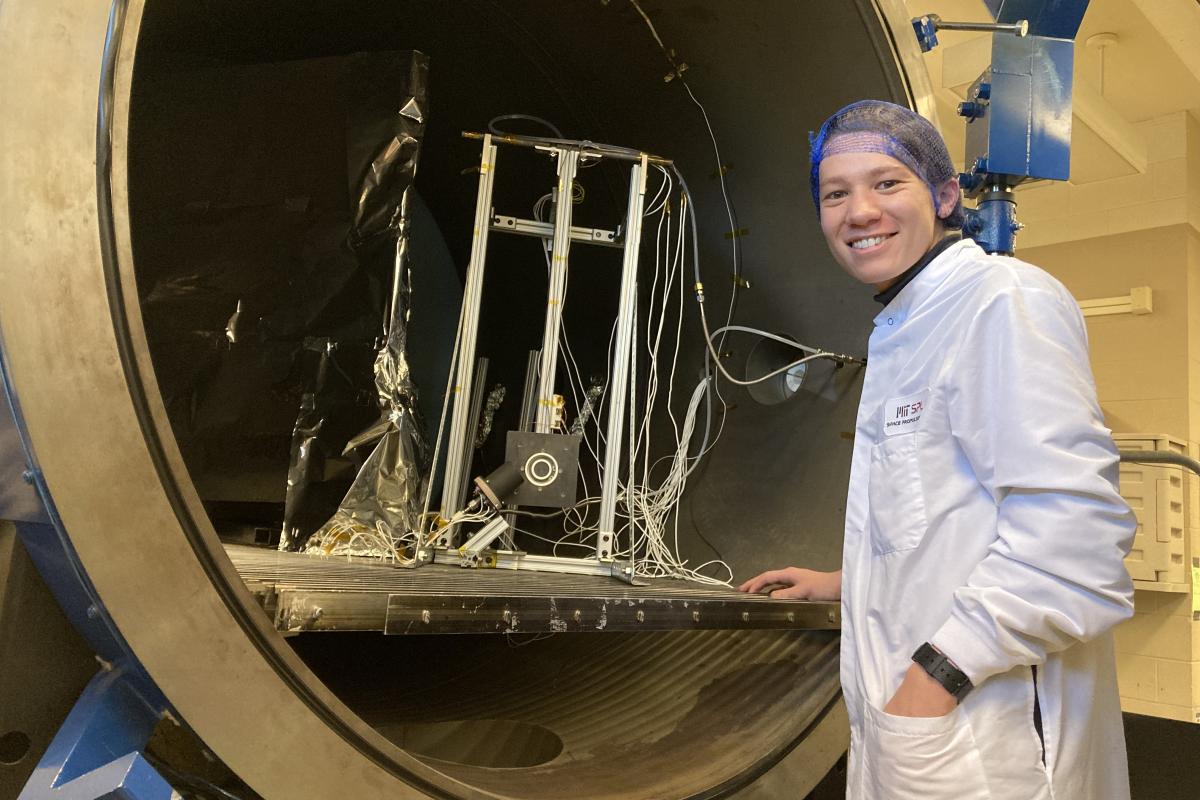
A multidisciplinary team of six students from the Olin Plasma Engineering Lab (OPEL) reached a major milestone at MIT’s Space Propulsion Lab on January 30, 2023: they achieved ignition.
On January 30, 2023, six students from the Olin Plasma Engineering Lab (OPEL), reached a major milestone at MIT’s Space Propulsion Lab: they achieved ignition. Making them the first undergraduate team in the world to successfully design, build and fire a steady-state Hall-effect thruster.
Day of the Test
A persistent and distinct whistle-chunk sound can be heard about once per second in the background of the cramped Cambridge lab with the giant silver and blue can, along with a medium-pitch, constant whirring/droning.
(Listen to the sounds of the day by clicking below)
The chunking noise is the compressor for the cryopumps. The constant whirring is the "rough pump."
The cryopump maintains high vacuum by dropping the temperature of a metal plate down to a few degrees above absolute zero so that when atoms touch it, they instantly freeze and get stuck. The rough pump pulls enough of an initial vacuum for the cryopumps to take over. Both are integral to the day's mission. Both form its underlying soundtrack.
Now after three days on site, setting up, testing, measuring, the ring - suspended by a metal stand inside the giant can, begins to emit a steady, purple glow. "A beautiful glow."
Low buzzing is heard. A camera recording video and audio jostles and then a student's voice calls out. Unsure of what is being seen. "It looks like it's running." "Is it?"
Then the confirmation and... "Yes, yes!!"
(Listen to the sounds of the day by clicking below)
Ignition has been achieved.
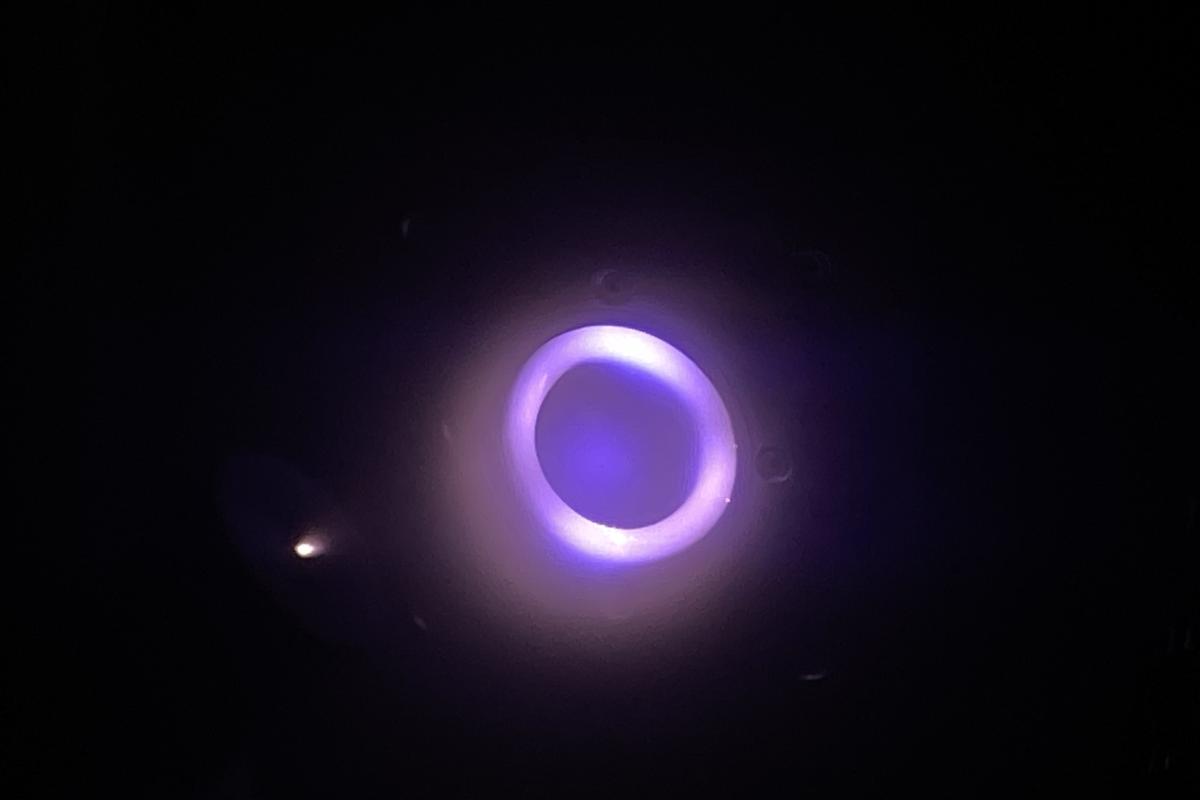
The glowing substance pictured in the ring is a plasma ejected from the thruster. Photo by Braden Oh '23
Immediately after: "Oh wow..." A student's voice calls out, "Wait the magnet is at .1 amp." "It looks on. It's a pulse [fire], but it's on," he reports.
"Oh, awesome..."
More camera jostling. "The thruster is pulsing... it's pulsing quite a lot. How interesting," says another student. A robotic-sounding voice continues to be heard in the background, echoing from an iPhone speaker. Asking pointed questions. Offering on the spot guidance.
(Listen to the sounds of the day by clicking below)
Afterward, there's relief and disbelief from the students. People begin to filter in and out of the room to get a good look at the thruster. The flow meter, vacuum gauge and various other devices and equipment is checked.
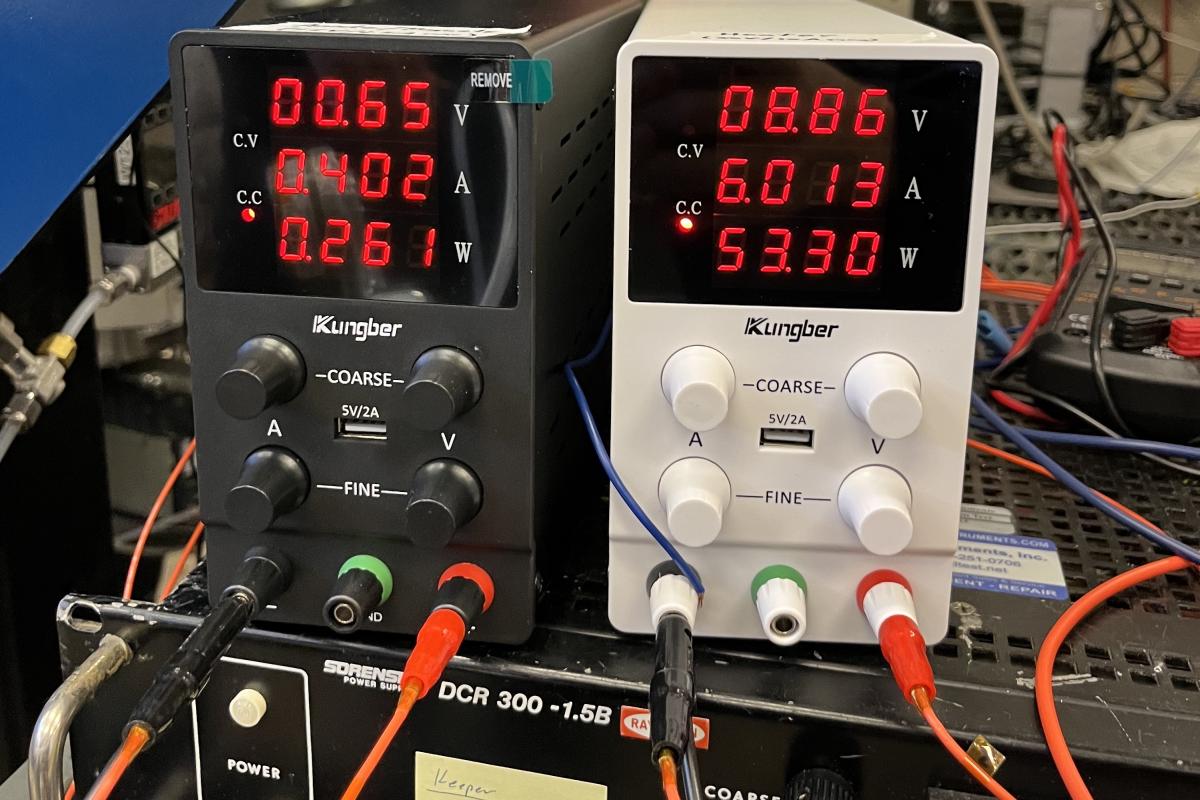
A photo of the power supplies used by the OPEL Lab students to ignite the cathode and control the magnetic field of the thruster on Jan. 30, 2023.
Background and Implications for the Future
When spacecraft lift off earth, the rockets that carry them use chemical propulsion. This is the plume of flame and smoke seen at rocket launches. It’s also the reason, besides the thunderous noise, that your pulse quickens, and eyes widen when viewing a launch in person.
In space, we can take advantage of vacuum and low gravity to use a much more efficient type of thruster (thrusters, along with a power source, are two parts of an electric propulsion system) for moving modern spacecraft between orbits and interplanetary destinations. More efficient, yes, and experiencing ignition of an ion thruster (also called an ion engine) here on earth is certainly as exciting.
Just ask the six students from the Olin Plasma Engineering Lab (OPEL), who on January 30, 2023, reached a major milestone at MIT’s Space Propulsion Lab: they achieved ignition.
The multidisciplinary team of Olin, Wellesley College and Brandeis University undergraduates, led by Olin E:Physics major, Braden Oh ‘23, successfully ignited their own ion thruster that day – called a Hall-effect thruster (HET) - making them the first fully undergraduate team in the world to successfully design, build and fire one at steady-state.
"It was a beautiful glow. I had seen photos of thrusters, but nothing compared to seeing the thruster in person working. We could only look through a small window in the vacuum, but it was still a beautiful sight," says OPEL Lab member and testing camera-person, James Jagielski '25.
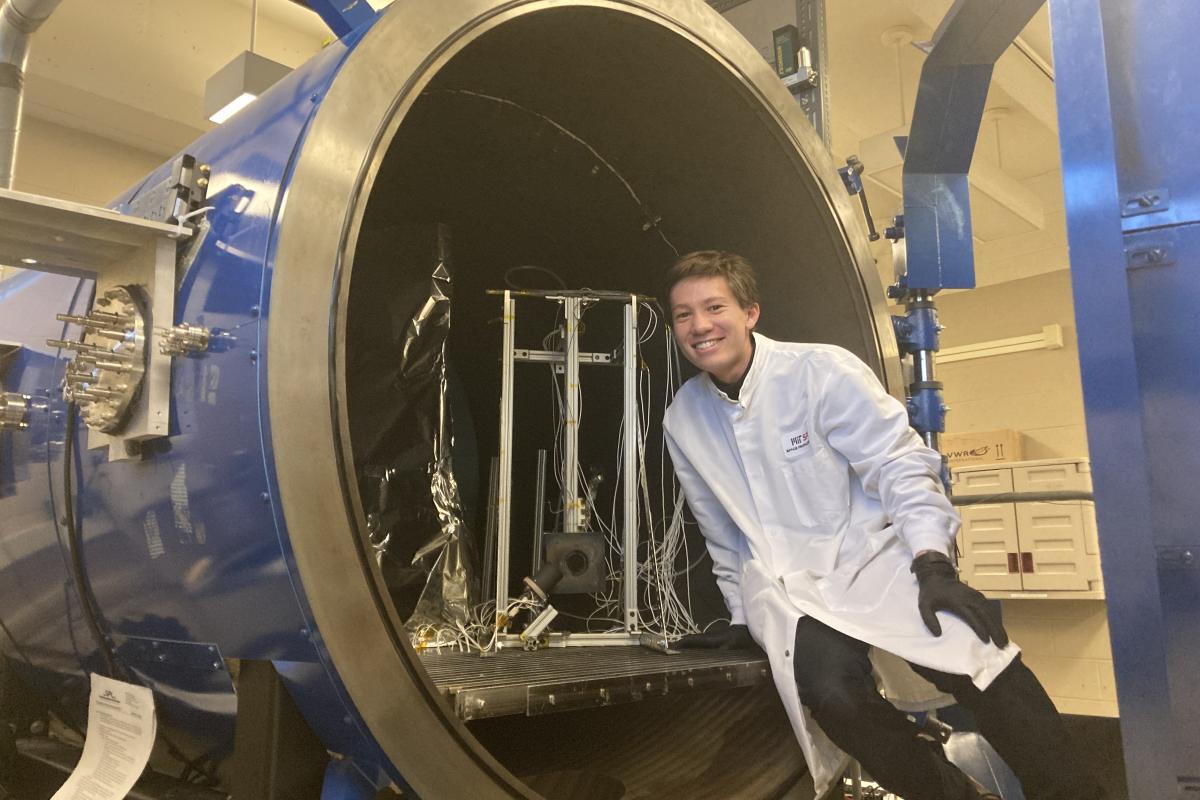
The smile says it all. Braden Oh '23 poses with the ion thruster after a successful test-fire in the MIT Space Propulsion Lab on January 30, 2023.
Based on a published literature search, the OPEL Lab is now confirmed to hold two titles independently: the first fully undergraduate team to design and pulse fire a Hall-effect thruster, and the first undergraduate team to fire one at steady state.
What does this achievement mean to the students, and what implications might it have for young engineers and student researchers in general?
For one thing, being able to build a steady-state Hall thruster as undergraduates demonstrates to the team that the technology isn’t so complex that only graduate level researchers can understand it.
"Historically, research in electric propulsion has been confined to a small number of well-funded graduate schools in the country, but this demonstration shows that an undergraduate team can learn enough fundamentals to design, build, and test a Hall thruster for surprisingly little cost," says OPEL Lab member, Braden Oh '23.
Being a part of the first undergraduate team to achieve ignition of a thruster "feels amazing," says Jagielski '25. "This team is fantastic, and we all get along really well."
For first year Olin student and OPEL Lab member Lily Dao '26, this accomplishment means pushing a field forward.
"As we made progress toward becoming the first undergraduate team to ignite a thruster, we came across many areas where research just didn’t exist yet."
"I realized I've now reached the point in my education where I'm in the position to make an impact, pushing what people know about electric propulsion forward," says Dao '26.
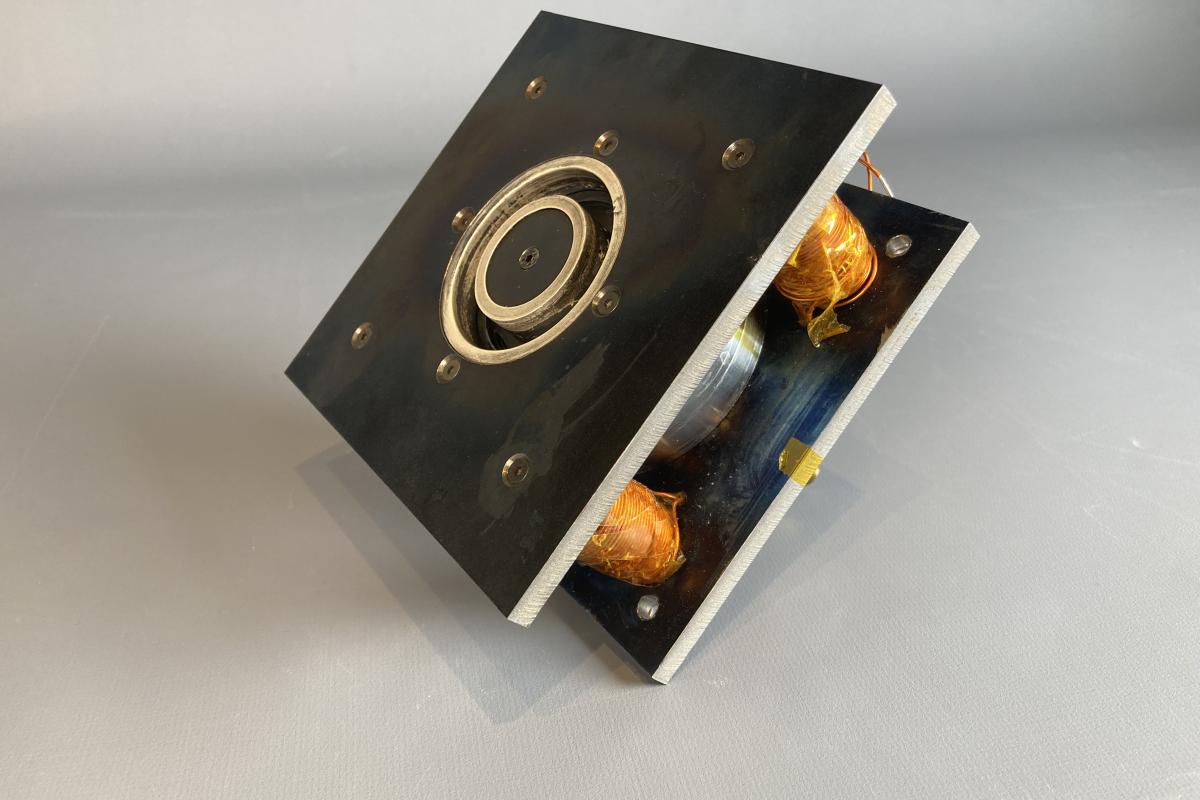
Close-up image of the OPEL-built ion thruster. Photo by Braden Oh '23.
For a small group of promising, up-and-coming Olin engineers that are super passionate about the field, accessibility is also top of mind.
"This is incredibly exciting to me because it shows that the small field of electric propulsion is far more accessible to young engineers and researchers than has previously been thought," says Oh.
Hall-effect Thrusters (HET)
Hall thrusters are the most common type of ion thrusters. They’re capable of achieving large changes in velocity with much less fuel than a traditional chemical rocket. Ion thrusters eject ions instead of combustion gases to create thrust. Because of this they make attractive options for unmanned orbital transfer vehicles (OTVs), as well as for deep space and human missions, and are therefore subject of much research. Research that the OPEL students have been working on for over 4 years, studying the inner workings of electric propulsion rockets, and now culminating in January’s successful test-firing (they had an unsuccessful attempt in 2018.)
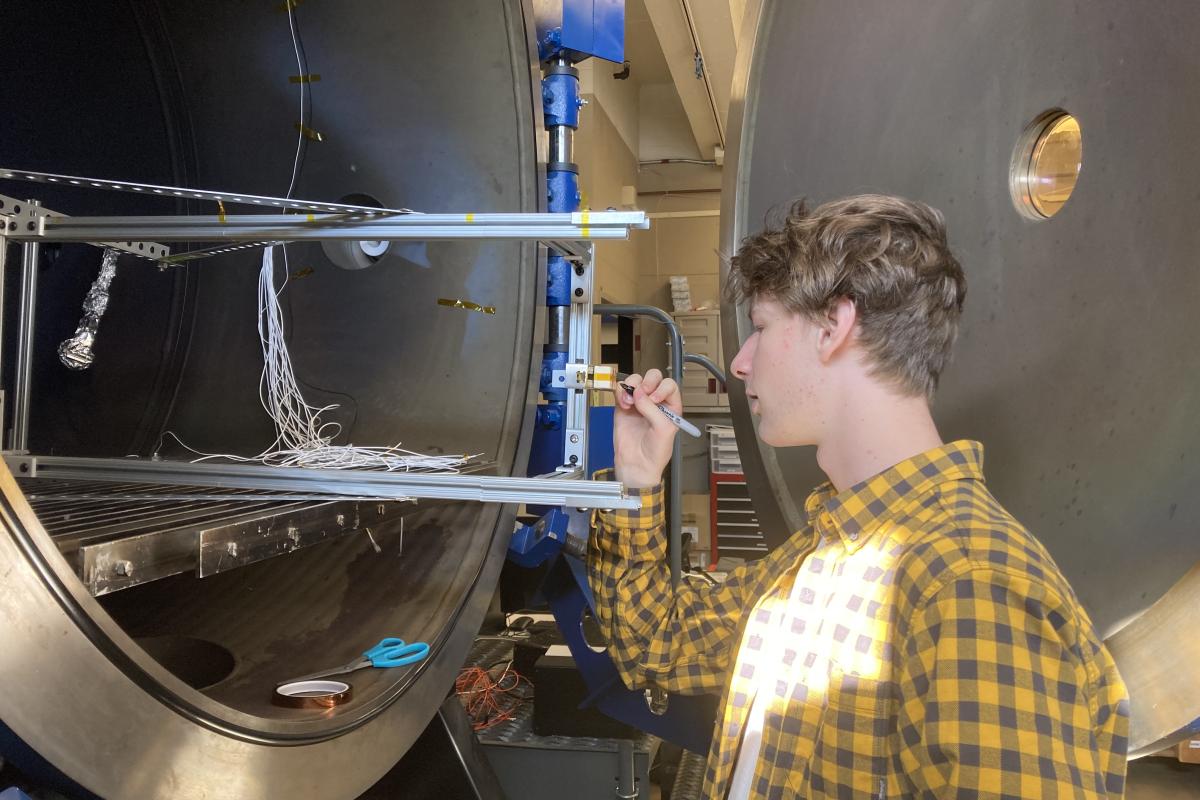
On the day of ignition, James Jagielski '25 marks a ceramic terminal block, which is a component that allows electrical connections to be made to a thruster easily and provides strain relief to components on the thrust stand.
Project Liftoff
The project began back in 2018 when Oh and Lauren Anfenson ’22, were interning at NASA’s Jet Propulsion Laboratory (JPL). They were introduced to the Hall-effect thruster alongside Oliners Jonah Spicher ’21 and Justin Kunimune ’19, and a spark was lit.
“After we saw the thruster’s test fire, we all tried to explain to each other how it worked, but we couldn’t,” says Oh. “We decided to learn to build one as part of an independent study that fall.”
Fast forward to 2021, when the students built the current thruster, and this past year they’ve been building the ignition system, using equipment (a cathode) generously donated by Plasma Controls.
Using that cathode, the team was able to successfully ignite plasma at Olin last semester (Fall, 2022), utilizing a special high-vacuum chamber that the students crafted themselves with the manufacturing advisement of an Olin College professor. This stage was a key part of the student's overall system, as NASA notes that plasma is the building block for all types of electric propulsion, where electric and/or magnetic fields are used to accelerate the electrically charged ions and electrons to provide thrust.
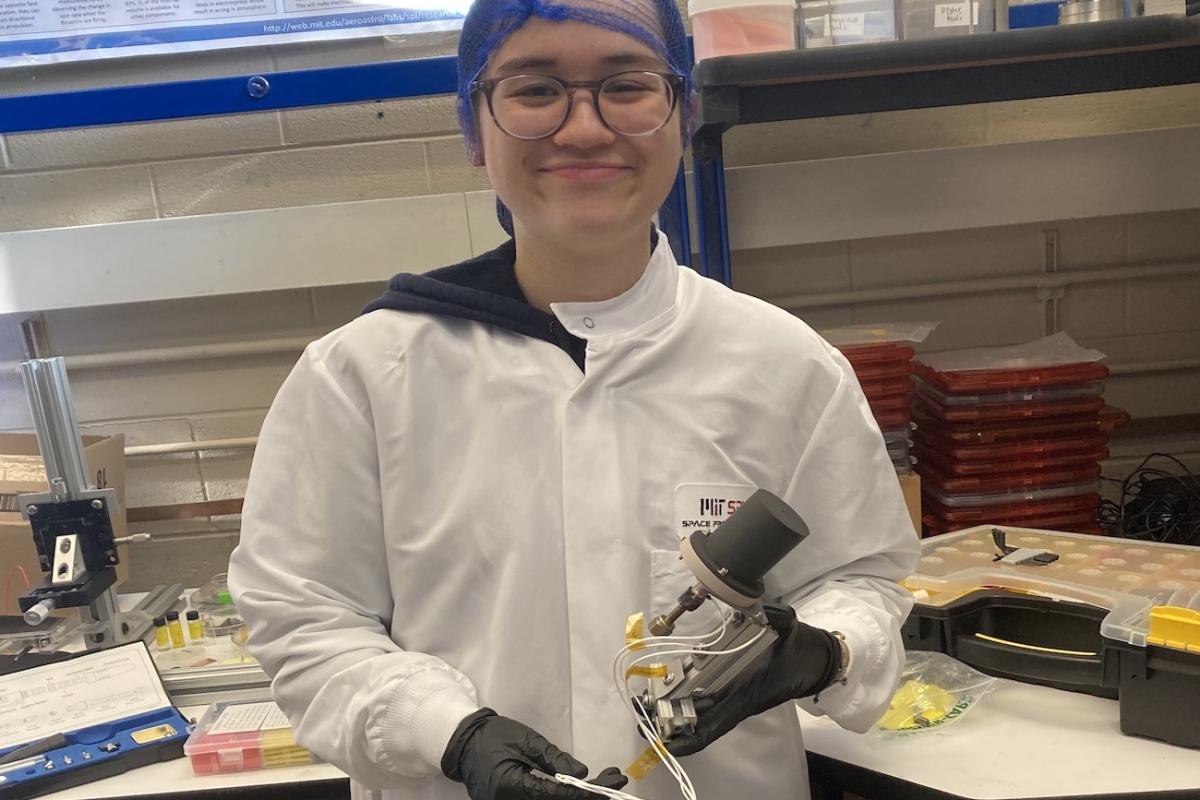
Lily Dao '26, an OPEL Lab member, is pictured in the MIT Space Propulsion Lab in 2023.
Mentors and Advisors
While the undergraduate students are operating at an amazingly high level of competency and professionalism – they were the only presenting undergrads to deliver an oral presentation (of their latest Hall thruster) at the International Electric Propulsion Conference (IEPC) in 2022 - along the way they’ve received help and guidance from mentors and advisors in a variety of fields - from Olin’s campus and off.
Olin‘s Christopher Lee, professor of mechanical engineering, currently serves as the Lab’s independent study advisor and sponsor for Massachusetts Space Grant funding. Lee has guided the group through challenges with mechanical design, project management, funding, and publication throughout the lifetime of the project.
"This is a spectacular demonstration of what intrinsically motivated students can do given resources and support. Occasionally, it takes a bit of creativity but I’m always happy to help clear some of the boulders blocking the path to ignition," says Lee.
Alessandra Ferzoco, assistant professor of measurement science at Olin, donated space and equipment in her own lab and aided in assembly of the group’s high-vacuum chamber.
Colorado State University’s John Williams, professor of mechanical engineering and director of the Electric Propulsion & Plasma Engineering Laboratory (CEPPE) at the school, arranged for the cathode donation - an expensive piece of equipment that turned out to be the critical piece that enabled the Olin students to test their thruster.
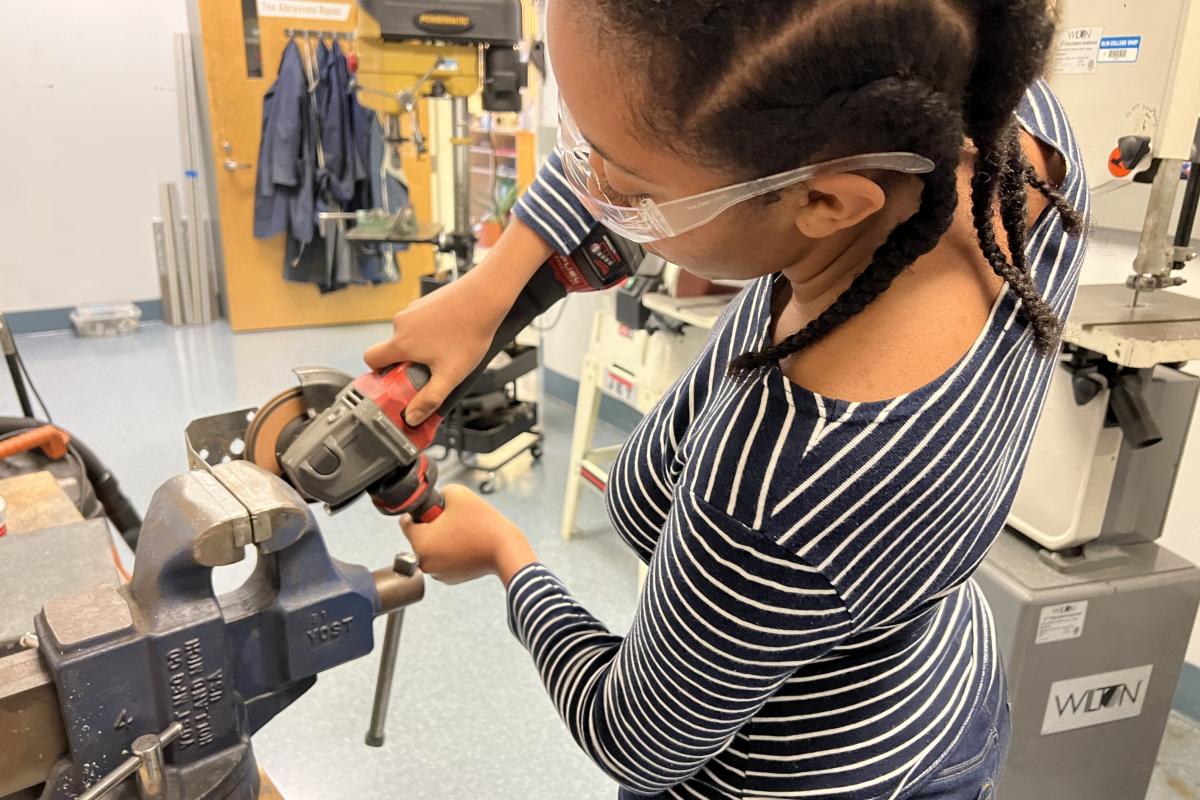
Mahderekal Regassa (Wellesley College '24,) a member of OPEL works with a tool in the Olin Shop.
Professor Williams - heard as the voice on the speakerphone pre and post ignition, also spent hours on the phone with the team of students over the three days, during testing and walking them through the startup procedures for both the donated cathode and the thruster.
It was Williams that could have provided the team with the much-needed spark they needed that day, with the ignition coming about an hour into the call.
Dr. Rebecca Christianson is a former Olin professor who advised the 2018 project and is now a Distinguished Member of the Technical Staff at Draper Labs. Dr. Christianson helped the students secure a sponsorship this year which helped fund the vacuum chamber and continues to serve as a technical mentor.
Dr. Dan Goebel of NASA JPL has provided technical and design guidance since the project first began, and MIT's Paulo Lozano, professor of aeronautics and astronautics and Director of the Space Propulsion Lab, has allowed the Oliners to test at the Cambridge Lab three times since 2018.
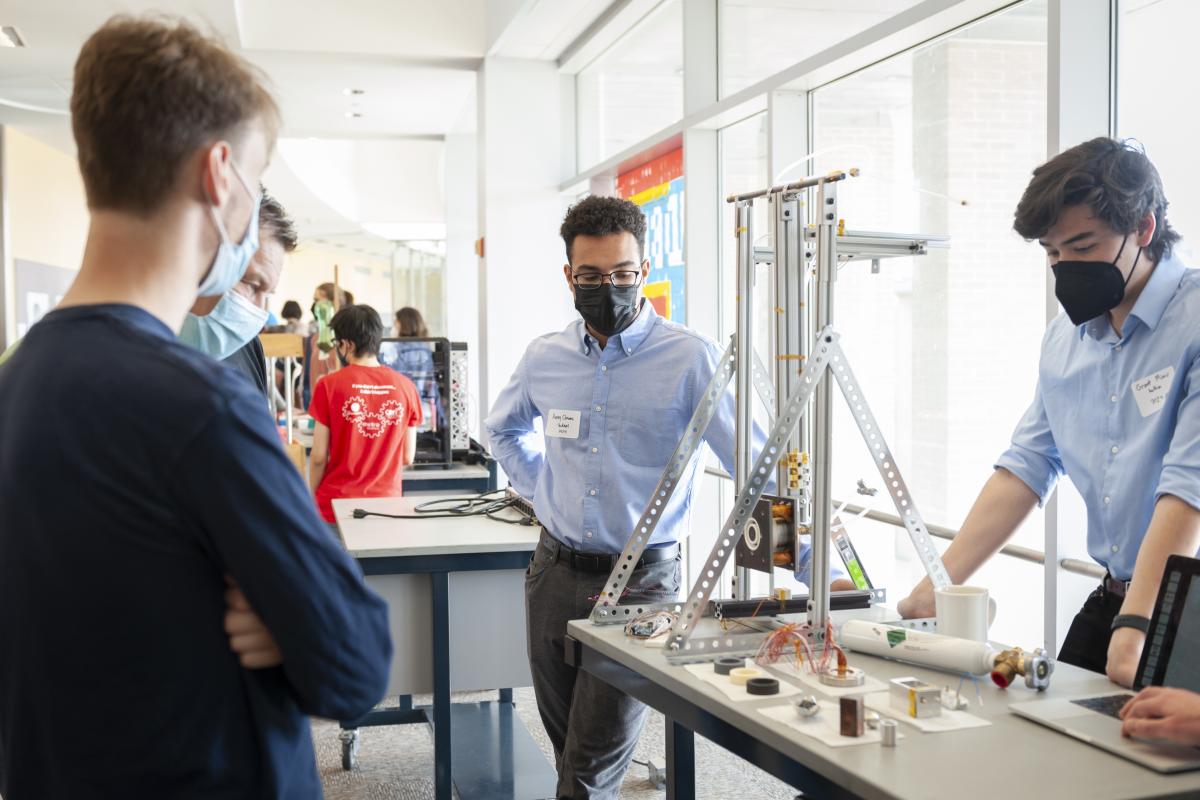
Avery Clowes ‘24 (center) and former Lab member Grant Miner ‘25 (behind table), look at the thruster in its stand while interacting with the Olin community during Spring Expo 2022. Photo by Leise Jones.
Next Stop...Mars?
The Lab's work to date has been peer reviewed and published by the Journal of Electric Propulsion and ASEE, and the PEEP students have presented at AAS and the International Electric Propulsion Conference. Their ASEE paper won the Aerospace Division Distinguished Student Paper Award at the 2020 conference where it was published and the undergraduates hold a provisional patent on the gas diffuser tested in their prototype ("Additively Manufactured, Azimuthal Gas Diffuser for Hall Thrusters," US Provisional Patent Application No. 63/340566, filed May 11, 2022).
The students are dedicated and sincere about the work, positing that electric propulsion technology is going to be incredibly important to our future. Presently, there is a unique opportunity for the next generation of Olin students.
"With a boom in the satellite industry driving unprecedented demand for electric propulsion engines, right now is a unique opportunity to expand and diversify the community; I hope that our work can inspire and guide the next generation of engineering students who are interested in entering the field of electric propulsion!, says Oh.
In the fall Braden will continue the work, beginning a Ph.D. program at the University of Michigan through the Plasmadynamic & Electric Propulsion Lab, led by Professor Ben Jorns. Jorn's lab is performing research in high power plasma propulsion.
Lab members such as Jagielski, an Olin sophomore who says this thruster project has been a great opportunity to mix an interest in space with his electrical engineering education, will stay on with OPEL. Dao, too. Motivated no doubt in part by that sweet moment at the end of January.
"Once [the thruster] ignited there was a moment of relief and disbelief. We were all super excited and congratulated each other. This was an incredible moment and I’m so happy to be a part of it," Jagielski says.
For Dao, this year has been especially meaningful - as a student new to Olin, and to electric propulsion.
"This project has provided me with a footing within the school and in the field of engineering. It gave me confidence as an engineer to have independent ideas and to share those ideas."
Oh is excited and eager to join the new team in Michigan, and says he hopes to take everything learned and achieved at Olin and with the OPEL Lab, to help bring us all "one step closer to the engines that will carry us to Mars!"
Members of OPEL pictured (L to R): Braden Oh '23, Albert Countryman (Brandeis '24), Lily Dao '26, James Jagielski '25, Mahderekal Regassa (Wellesley College '24). (Not pictured is Avery Clowes ‘24).
OPEL is:
Current members:
- Braden Oh (E:Physics ‘23)
- Avery Clowes (ME ‘24)
- Albert Countryman (Brandeis University, Physics ‘24).
- Lily Dao (ME ‘26)
- James Jagielski (ECE ‘25)
- Christina Crochetiere (Babson College, Business & Entrepreneurship ’25)
Former members:
- Grant Miner (ECE '24) designed and built the first prototype of the team's measurement instruments.
- Simon Kemp (ME '23) designed and built the thrust stand.
- Mack McAneney (ME '23) designed and built the thrust stand.
- Mahderekal Regassa (Wellesley College, Astrophysics ‘24).
Lab alumni and contributions:
- Marissa Klein, a 1st year Ph.D. student at University of Virginia (Wellesley College, Astrophysics '21) wrote data collection and visualization software, participated heavily in the authorship of the team's papers, and continues to advise the team remotely.
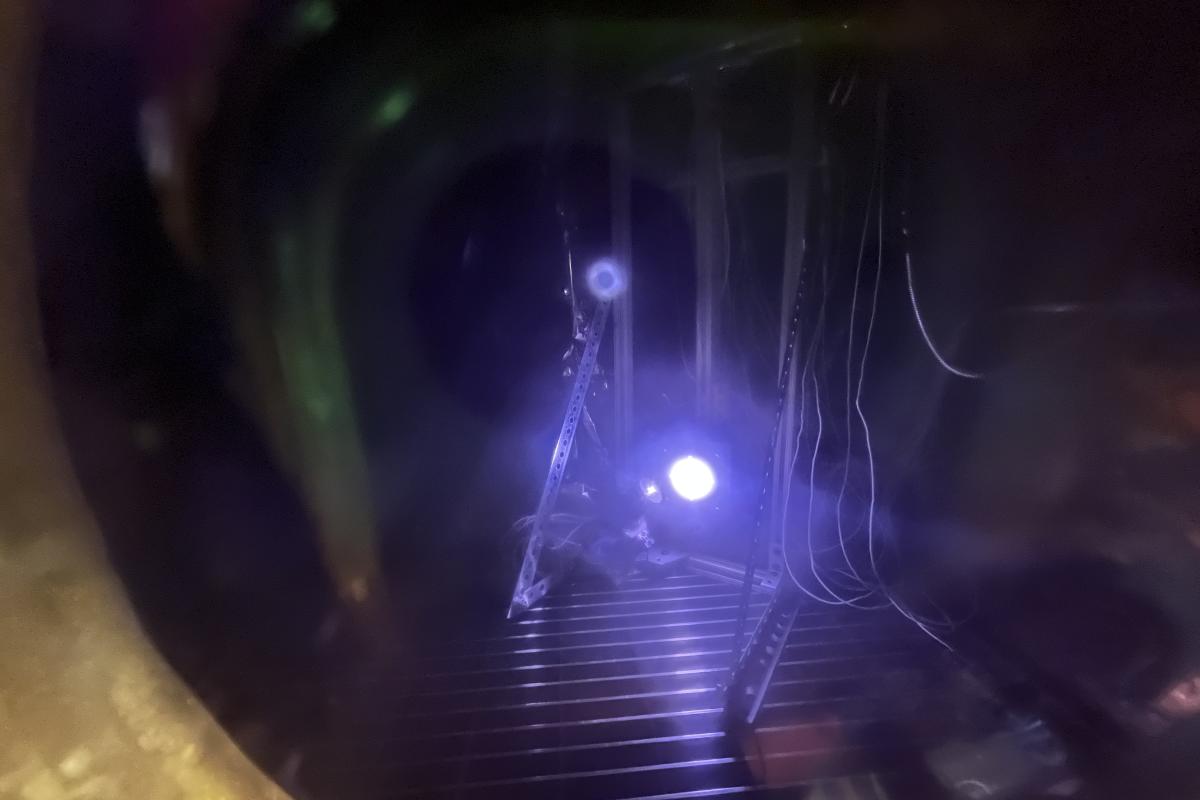
Watch the first ignition of the Hall-effect thruster (HET) on January 30, 2023.